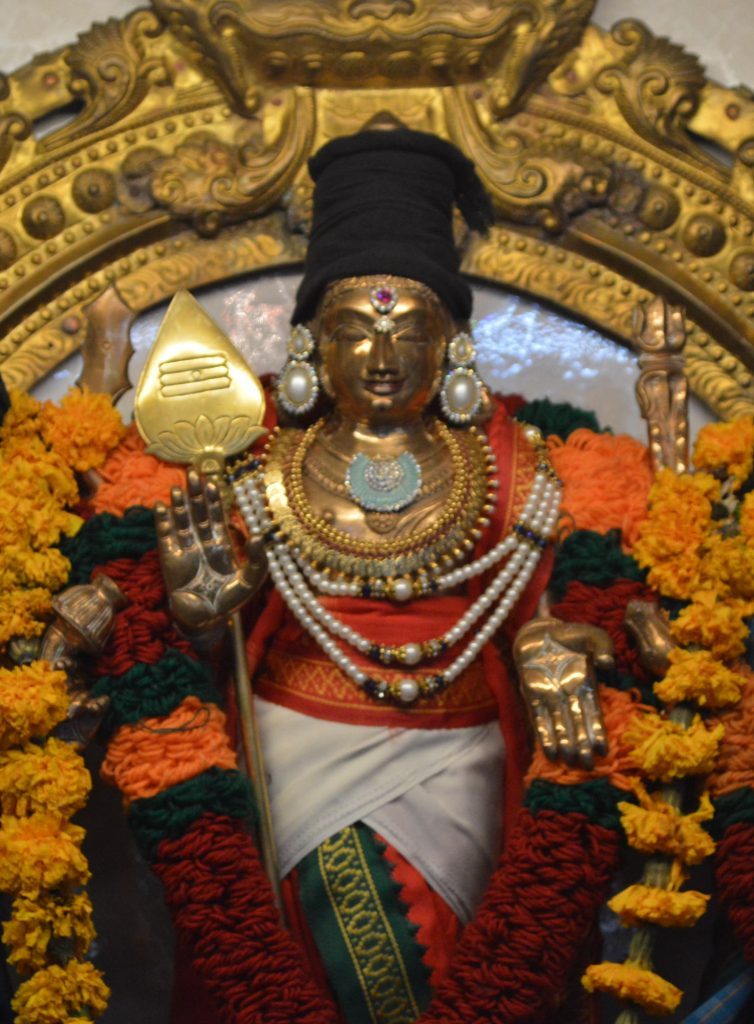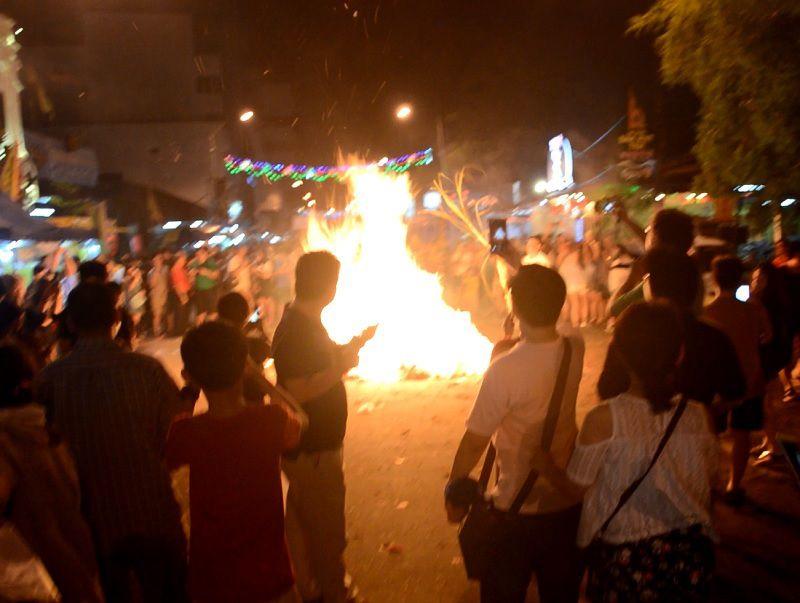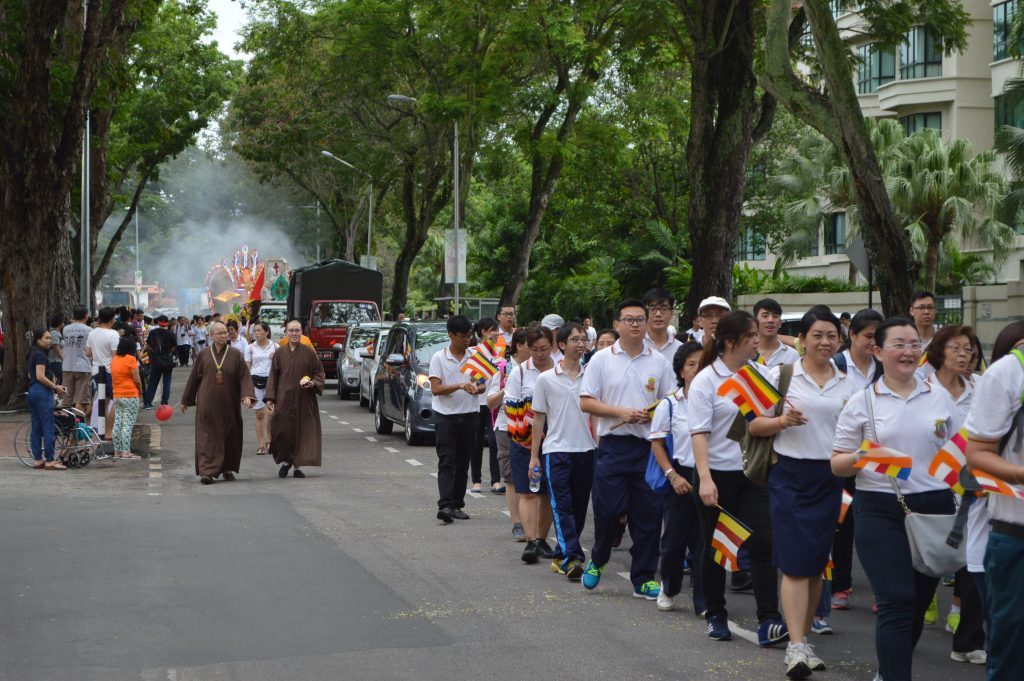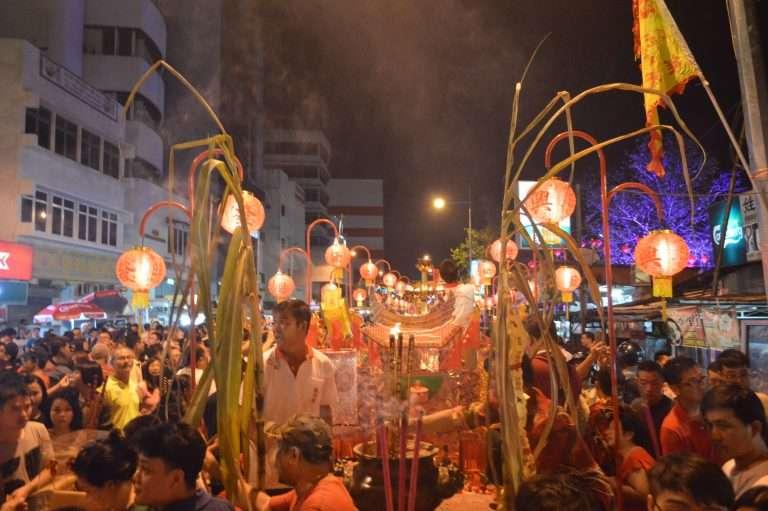Cultural Diversity is the catalyst for the best Penang festivals. As a result, Penang offers an explosive (literally) festival season that occurs annually during the spring time. Additionally, three of the largest Penang festivals occur at about the same time. As a result, travelers to Penang can enjoy a cultural treat in one spot. Otherwise, they would have to travel to several different countries to enjoy the same diversity that Penang offers. There is no other place in the world that can match the Penang Festivals.
Penang’s unrivaled cultural excellence is based on what Malaysian’s call the “cultural triangle”. A triangle is used as a metaphor because in the State of Penang, over 94% of the population is divided in to 3 large sub-groups. These three groups are the Malay, Chinese and Tamil Indians.
- Hindu Thaipusam Festival
- The Best Chinese Festivals
- Hokkien Pai Ti Kong Festival
- The Wesak Buddhist Festival
- Hari Raya Aidilfitri Muslim Festival
Origin of Ethnic Diversity in Penang, Malaysia
The origin of Penang’s diversity was the expansionist ambitions of the British Empire. Indeed, the colonial interests of the British were primarily in Malaysia’s rich agricultural potential. As a result, the main attractions were tin mining and rubber plantations. However, during WWI and WWII global demand for these commodities exploded!
To meet the insatiable global demand, the British strongly encouraged immigrants from their other colonies to come and work in Malaysia’s tin mines, sea ports and rubber plantations. The primary source of labor would be their large colonial possessions in India and China. Additionally, the immigrants would provide financing from their home countries and also fill administrative positions in the growing local economy.
As a result of the these factors, the Tamil Indians and Chinese formed strong ethnic communities in Penang, Malaysia. In combination with the indigenous Malay population, these unique cultural communities would remain to form the population of Malaysia after independence from British rule. As a result, they would form the three corners of the Malaysian “cultural triangle”.
The Primary Penang Festivals
The lasting legacy of British colonialism in Penang is this unique cultural diversity. This is because the three primary ethnic groups of Penang all remain strongly devoted to the cultural and religious practices of their forefathers. As a result, there is an eclectic mix of ethnic holidays every year. Additionally, these traditional Penang festivals have been recently supplemented with additional events that further enhance their appeal to visitors.
Nonetheless, the four primary Penang festivals are Wesak Day, Thaipusam, Chinese New Year (including Pai Ti Kong) and Hari Raya Aidilfitri. As a result of the cultural triangle, all 4 of these celebrations carry strong religious and cultural implications. The primary religions being Hinduism, Buddhism, Chinese folk religion (deities) and Islam respectively. Additionally, this religious diversity is further divided along ethic lines – Tamil Indian (Hindu), Chinese (Buddhist, folk) and Malay (Islam).
ISLAM + HINDUISM + BUDDHISM + CHINESE DEITIES = PENANG, MALAYSIA
Penang Festivals Occur Worldwide
Indeed, the Penang festivals are certainly not exclusive to Penang. It is important to note that these cultural festivals occur globally wherever communities of Tamil Indian, Buddhist, Chinese or Muslim populations exist. What is unique about Penang is that all of these festivals are celebrated here.
To be clear, Malaysia is a multicultural country and the multicultural Penang Festivals are for everyone who wishes to join in. Nonetheless, the celebrations are still heavily divided along ethnic lines just the same.
Below, is a short description of the 4 main Penang Festival celebrations. Please note that the list is not all inclusive and there are many additional celebrations here throughout the year.
Thaipusam is Penang’s Best Hindu Festival
Far and away, the Penang festival with the largest attendance is Thaipusam. Thaipusam is predominately celebrated by Tamil Indians in countries that have a large Tamil population. Malaysia has a large population of Tamil Indians, therefore the Penang Thaipusam festival is huge including all of the domestic and international visitors.
The word Thaipusam can be broken down into 2 words. Thai which means the Tamil month of January/February and Pusam is the name of a star. The Pusam star reaches it’s highest point in the night sky on the day of the Thaipusam celebration. Additionally, this Penang festival is held during the full moon that occurs during the Tamil month of “Thai”.
The ancient theme of the celebration was the giving of the spear “Vel” to Lord Murugan by mother, the Hindu Goddess Parvati. As a result of this sacred weapon, Lord Murugan was able to vanquish the demon army of “Asuras”. The Thaipusam Festival is the annual victory celebration which commemorates the defeat of the demon army.
Lord Murugan Statue

The focal point of the Thaipusam festival is centered around two of Lord Murugan’s temples located in Penang. The two Hindu temples are both located on Jalan Kabun Bunga near the Penang Botanical Gardens. Additionally, the names of the two temples are the Nattukottai Chettiar Temple and the Arulmigu Balathandayuthapani Temple also known as the “Waterfall Temple”. Needless to say, both of these Hindu temples are dedicated to Lord Murugan.
Traditionally, there had only been a silver chariot procession. However, starting in 2017 the Penang Thaipusam Festival included both a silver and golden chariot procession. As a result, in both 2017 and 2018 the 3 day Penang Thaipusam Festival attracted well over 1,000,000 devotees.
The Best Chinese Festivals in Penang
Also known as “Chinese New Year Celebrations“, the Spring Festival is the most significant Chinese holiday of the year. Therefore, every year in January/February the Chinese celebrate the change from winter solstice to spring equinox. Additionally, the Chinese new year falls on the new moon that begins annually between January 21 and February 20.
The Chinese Spring Festival celebrations start on the eve preceding the new moon and end on the 15th day of the following calendar month. In China it is by far the biggest national holiday event of the year. As a result, Chinese populations residing outside of China devoutly celebrate the Chinese Spring Festival. Therefore, Chinese Spring festival is also a most spectacular celebrations in Penang.
The celebrations will last for two weeks with large fireworks displays and events throughout George Town. However, there is one special night that is dedicated to the Chinese New Year Street Party celebrations. As a result, for one night, the central downtown area is closed to all vehicle traffic. Throughout this closed off area there is a large selection of Chinese food delights to indulge in. Additionally, there are the multiple stage performances featuring traditional music and dancing. Don’t miss the lion dance which is performed by a world class troupe from Shanghai!

Pai Ti Kong Penang Festival
The majority of the Chinese population in George Town, Penang are of Hokkien descent. Therefore, one special night during Chinese New Year is dedicated to the Pai Ti Kong Festival. As a result, this day is commonly referred to as the “Hokkien New Year”.
Specifically, the Hokkiens are honoring the “Jade Emperor” also known as the “God of Heaven”. The Hokkiens believe that the Jade Emperor saved their ancestors from a ruthless Mongol army in ancient China. Therefore, the Hokkiens pay tribute to the God of Heaven every year during the Pai Ti Kong Festival.
The Pai Ti Kong celebration begins on the eve of the 8th day of Chinese New Year at Pengkalan Weld (Chew Jetty). Additionally, Pai Ti Kong is one of the most politically important Penang festivals. As a result, the Penang Chief Chief Minister is sure to attend every year. Furthermore, visitors are bedazzled with gratuitous fireworks displays and Kim Cua offering fires light up the night.

Wesak Day Festival
Wesak Day commemorates the birthday, enlightenment and Paranirvana (death) of Gautama Buddha. However, Wesak is actually a deviation from the Pali term Vesakha. Indeed, they pronounce the word a bit differently in Penang. Nonetheless, Wesak Day is the most prominent Penang festival celebrated by the local Chinese Buddhists.
Wesak Day celebrations are held in the spring, usually in the month of May. However, the specific day of the celebrations can fluctuate due to variations in the lunar calendar. As a result, they typically are not held on the same day in every country. Although they are based on the same Theravada Buddhist traditions.
The Chinese population in Penang is mostly Buddhist and therefore Wesak Day Festival is very important here. Other important symbols of Buddhist dedication in Penang include the Kek Lok Si Temple or “Temple of Supreme Bliss” in Hokkien.
Wesak Day Procession
In Penang, Buddhist devotees rise early and flock to the local temples to venerate the Buddha. Additionally, devotees engage in acts of charity throughout the day. As a result, there is distribution of free vegetarian meals and doves are also set free.
However, the celebrations don’t reach their apex until the commencement of the Wesak Day Procession which occurs in the evening. The grand procession begins at the Malaysian Buddhist Association on 182 Burma Road and passes through the streets of George Town.
The procession includes beautiful floats covered with flowers, children singing, monks chanting and sprinkling holy water on devotees. Additionally, Wesak Day has been celebrated in George Town every year since 1949!

Eid al-Fitr Muslim Festival
Eid al-Fitr is a Muslim holiday celebration that commemorates the end of the Ramadan fast. As a result, the celebration begins at the conclusion of the month of Ramadan. Additionally, the day it begins can fluctuate due to the annual variations of the lunar calendar.
The reason for the fluctuation is that observers wait until the arrival of the new moon which concludes the month of Ramadan and ushers in the new month. As a result, this is typically June/July on the western calendar. However, the arrival of the new moon must be verified by local authorities. Therefore, the specific date varies by locality worldwide.
In Malaysia, Eid al-Fitr is known as Hari Raya Aidilfitri. Additionally, the Malay translation of Hari Raya is “celebration day”. Indeed, Malaysia is a Muslim majority country. As a result, Hari Raya Aidilfitri carries great significance as one of the prominent Penang Festivals.

During Hari Raya Aidilfitri, Muslims commonly greet each other by saying “Selamat Hari Raya” which means “Happy Eid”. Additionally, it is a time when workers in the city return home to the Malay villages and visit family members. Furthermore, it is common for Malaysian Muslims to wear traditional clothing for the celebration and to welcome neighbors into their homes.
Additional Penang Festivals
Penang Hot Air Balloon Festival
Dragon Boat Festival at Teluk Bahang
Kek Lok Si Temple

